A Study on the Soil Passivation of Nano-Manganese Dioxide-Modified Biochar under High-Arsenic Water Irrigation
Abstract
:Highlights
- Nano-manganese dioxide modified biochar was prepared.
- It is proved that nano-manganese dioxide modified biochar can effectively reduce the effective arsenic content in soil.
- When biochar, potassium permanganate and manganese sulfate monohydrate are mixed in a mass ratio of 1:0.18:0.29, manganese can be loaded onto the surface of biochar more efficiently.
- It can promote the prevention and control of high arsenic groundwater. Among them, the preparation of passivation materials and the experimental design of potting can also provide certain reference value for the passivation and restoration of arsenic-contaminated soil.
Abstract
1. Introduction
2. Materials and Methods
2.1. Test Material
2.1.1. Preparation Process of Nano-MnO2-Modified Biochar Passivator
2.1.2. Test Soil and Crops
2.1.3. Test Water
2.2. Experimental Design
2.3. Sampling and Sample Determination
2.4. Adsorption Model
2.5. Characterization Methods
2.6. Data Processing and Computing
3. Results
3.1. Study on the Adsorption Characteristics of Biochar
3.1.1. Experimental Exploration of Adsorption Kinetics
3.1.2. Experimental Exploration of Adsorption Isotherms
3.2. Effect of Passivator on Soil Effective Arsenic Content under High Arsenic Water Irrigation
3.2.1. Analysis of Changes in Soil Effective Arsenic Content under Different Addition Ratios
3.2.2. Study on the Arsenic Fixation Effect of the Passivator under Planting Crop Conditions
4. Discussion
4.1. The Arsenic Fixation Mechanism of Modified Biochar
4.2. Influencing Factors of Effective Arsenic Content Change in Soil Systems
5. Conclusions
Author Contributions
Funding
Data Availability Statement
Acknowledgments
Conflicts of Interest
References
- Sun, G. Research progress on endemic arsenic poisoning in China. J. Environ. Health 2009, 26, 1035–1036. [Google Scholar]
- Guo, H.; Guo, Q.; Jia, Y.; Liu, Z.; Jiang, Y. Chemical characteristics and geochemical processes of high arsenic groundwater in different regions of China. J. Earth Sci. Environ. 2013, 35, 83–96. [Google Scholar]
- Report on the National General Survey of Soil Contamination; Ministry of Environmental Protection: Singapore, 2014. Available online: http://www.zhb.goVcn/gkml/hbb/qt/201404/t20140417_270670.htm (accessed on 20 May 2023).
- Liu, G.; Chen, M.; Li, W.; Gong, W. A critical review on the speciation and development of sequential extraction procedures for arsenic in soils. J. Agro-Environ. Sci. 2018, 37, 2629–2638. [Google Scholar]
- Hu, L. Study on Species Transformation and Phyto-Availability of Arsenic in Soil. Master’s Thesis, Chinese Academy of Agricultural Sciences, Beijing, China, 2008. [Google Scholar]
- Ren, Y.; Cao, W.; Xiao, S.; Li, X.; Pan, D.; Wang, S. Research progress on distribution, harm and control technology of heavy metals in soil. Geol. China 2023, 10, 231. [Google Scholar] [CrossRef]
- Li, Y.; Shang, J.; Huang, Y.; Wang, N. Research progress on passivation materials for cadmium-arsenic co-contamination in soil. Acta Pedol. Sin. 2021, 58, 837–850. [Google Scholar]
- Yang, J.; Bonheur, G.; Jiang, N.; Zu, Y. The immobilization remediation of cadmium and arsenic combined contaminated soils: A review. Environ. Poll. Control 2021, 43, 1189–1195+1200. [Google Scholar]
- Collivignarelli, M.; Sorlini, S.; Milanese, C.; Iiiankoon, W.; Caccamo, F.; Calatroni, S. Rice Industry By-Products as Adsorbent Materials for Removing Fluoride and Arsenic from Drinking Water-A Review. Appl. Sci. 2022, 12, 3166. [Google Scholar] [CrossRef]
- Amin, M.; Ahmad, M.; Farooqi, A.; Hussain, Q.; Ahmad, M.; AI-Wabel, M.; Saleem, H. Arsenic release in contaminated soil amended with unmodified and modified biochars derived from sawdust and rice husk. J. Soils Sediments 2020, 20, 3358–3367. [Google Scholar] [CrossRef]
- Chen, Y.; Xu, J.; Lv, Z.; Xie, R.; Huang, L.; Jiang, J. Impacts of biochar and oyster shells waste on the immobilization of arsenic in highly contaminated soils. J. Environ. Manag. 2018, 217, 646–653. [Google Scholar] [CrossRef]
- Qin, S.; Xia, D.; Zhao, L. Stable remediafion of arsenic-contaminated soil by sludge-based biochar. J. Ecolo. Rural Environ. 2021, 37, 1481–1486. [Google Scholar]
- Oscarson, D.W.; Huang, P.M.; Liaw, W.K. The Oxidation of Arsenite by Aquatic Sediments. J. Environ. Qual. 1980, 9, 700–703. [Google Scholar] [CrossRef]
- Yu, Z.; Zhou, L.; Huang, Y.; Song, Z.; Qiu, W. Effects of a manganese oxide-modified biochar composite on adsorption of arsenic in red soil. J. Environ. Manag. 2015, 163, 155–162. [Google Scholar] [CrossRef] [PubMed]
- Mo, Y.; Gao, F.; Wang, Y.; Ma, H.; Zhang, Q.; Hu, C.; Cui, B.; Liu, C. Changes in soil physicochemical properties and urease activity as affected by reclaimed water irrigation and nitrogen fertilization. J. Irrig. Drain 2022, 4l, 95–100. [Google Scholar]
- GB/T 22105.2-2008; Soil Quality-Analysis of Total Mercury, Arsenic and Lead Contents in Soils-Atomic Fluorescence Spectrometry-Part 2: Analysis of Total Arsenic Contents in Soils. Standards Press of China: Beijing, China, 2008.
- GB/T 14848-2017; Standard for Groundwater Quality. Standards Press of China: Beijing, China, 2017.
- Sun, R.; Wang, J.; Peng, Y.; Wang, H.; Chen, Q. Mitigation of arsenic accumulation in arugula (Eruca sativa Mill.) using Fe/Al/Zn impregnated biochar composites. Environ. Sci. Pollut. R. 2021, 28, 4136–4146. [Google Scholar] [CrossRef]
- Liu, M.; Sun, F.; Lv, Y.; Xu, Y.; Li, M.; Wang, Y.; Yin, X.; Jiang, H. Remediation of arsenic-contaminated soil by nano-zirconia modified biochar. Environ. Sci. Pollut. R. 2021, 28, 68792–68803. [Google Scholar] [CrossRef] [PubMed]
- Fan, W.; Bian, Z.; Tian, X.; Zhang, J. Study on absorption of arsenic by immobilized nano-manganese oxide. Technol. Water Treat. 2013, 1, 60–64. [Google Scholar]
- Liang, X.; Gao, Z.; Fu, Q.; Liu, Y.; Zhu, J.; Hu, H. Passivation of arsenic-cadmium combined pollution in alkaline soil by manganese-modified rice straw biochar. J. Nat. Sci. Hunan Normal Univ. 2022, 45, 93–100. [Google Scholar]
- Yu, Z.; Huang, Y.; Lian, F.; Xie, L.; Liu, S.; Song, Z. Adsorption of arsenic(Ⅲ) on biochar-manganese oxide composites. J. Agro-Environ. Sci. 2015, 34, 155–161. [Google Scholar]
- Gao, X.; Peng, Y.; Guo, L.; Wang, Q.; Guan, C.Y.; Yang, F.; Chen, Q. Arsenic adsorption on layered double hydroxides biochars and their amended red and calcareous soils. J. Environ. Manag. 2020, 271, 111045. [Google Scholar] [CrossRef]
- Lu, X.; Wu, J.; Guo, Y. Advances in remediation of heavy metal contaminated soil by biochar. Appl. Chem. Ind. 2019, 48, 1172–1177. [Google Scholar]
- Wu, P.; Cui, P.; Zhang, Y.; Alves, M.E.; Liu, C.; Zhou, D.; Wang, Y. Unraveling the molecular mechanisms of Cd sorption onto MnOx—Loaded biochar produced from the Mn-hyperaccumulator Phytolacca americana. J. Hazard. Mater. 2022, 423, 127157. [Google Scholar] [CrossRef]
- Chen, J.; Wang, J.; Zhang, G.; Wu, Q.; Wang, D. Facile fabrication of nanostructured cerium-manganese binary oxide for enhanced arsenite removal from water. Chem. Eng. J. 2018, 334, 1518–1526. [Google Scholar] [CrossRef]
- Liang, T.; Li, L.; Zhu, C.; Ye, J. Cerium-manganese modified biochar immobilizes arsenic in farmland soils. Environ. Sci. 2019, 40, 5114–5123. [Google Scholar]
- Ouvrard, S.; Donato, P.; Simonnot, M.O.; Begin, S.; Ghanbaja, J.; Alnot, M.; Duval, Y.B.; Lhote, F.; Barres, O.; Sardin, M. Natural manganese oxide: Combined analytical approach for solid characterization and arsenic retention. Geochim. Cosmochim. Acta 2005, 69, 2715–2724. [Google Scholar] [CrossRef]
- Beesley, L.; Inneh, O.S.; Norton, G.J.; Moreno-Jimenez, E.; Pardo, T.; Clemente, R.; Dawson, J.J.C. Assessing the influence of compost and biochar amendments on the mobility and toxicity of metals and arsenic in a naturally contaminated mine soil. Environ. Pollut. 2014, 186, 195–202. [Google Scholar] [CrossRef] [PubMed]
- Ahmad, M.; Rajapaksha, A.; Lim, J.; Zhang, M.; Bolan, N.; Mohan, D.; Vithanage, M.; Lee, S.; Ok, Y. Biochar as a sorbent for contaminant management in soil and water: A review. Chemosphere 2014, 99, 19–33. [Google Scholar] [CrossRef]
- Li, G.; Khan, S.; Ibrahim, M.; Sun, T.; Tang, J.; Cotner, J.; Xu, Y. Biochars induced modification of dissolved organic matter (DOM) in soil and its impact on mobility and bioaccumulation of arsenic and cadmium. J. Hazard. Mater. 2018, 348, 100–108. [Google Scholar] [CrossRef] [PubMed]
- Ru, S.; Zhao, O.; Hou, L.; Xiao, G.; Wang, C.; Sun, S.; Zhang, G.; Wang, L.; Liu, L. Effects of eight kinds of passivators on properties and cadmium availability in different cadmium-contaminated soil. Ecol. Environ. Sci. 2021, 30, 2085–2092. [Google Scholar]
- Chen, X. The Research on Mixture Leaching Remediation Technology of Arsenic Contaminated Soil. Master’s Thesis, Hunan University, Changsha, China, 2016. [Google Scholar]
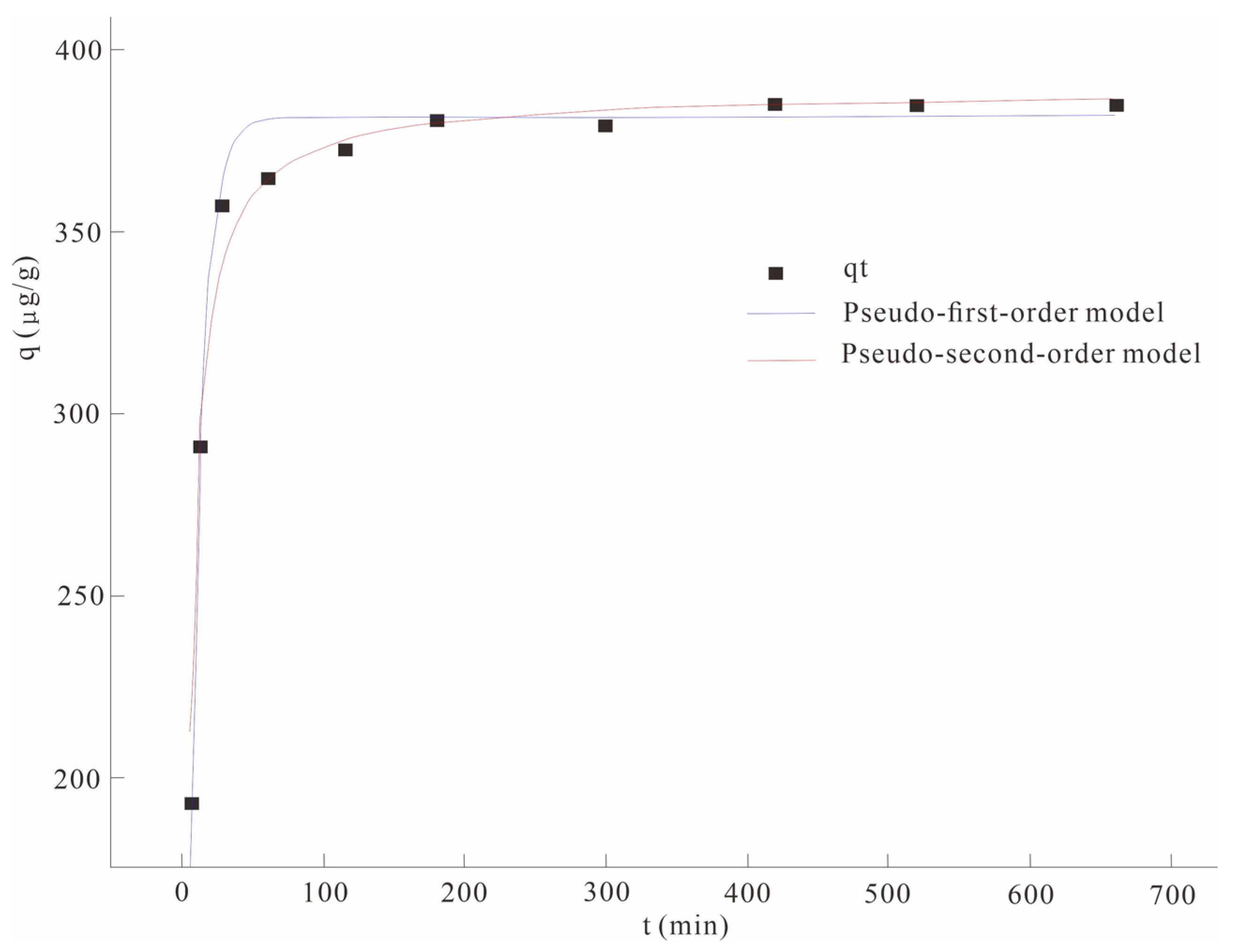
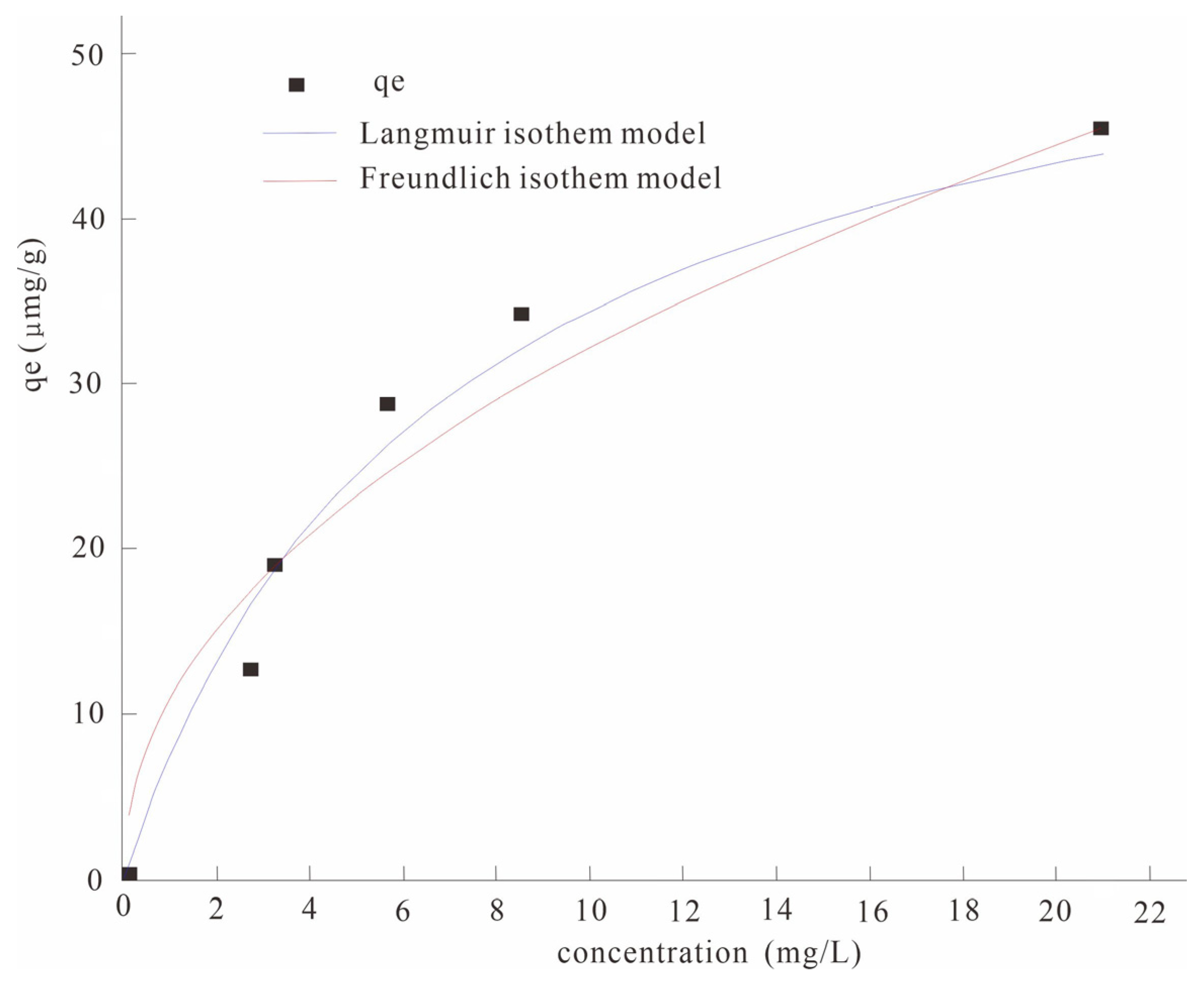
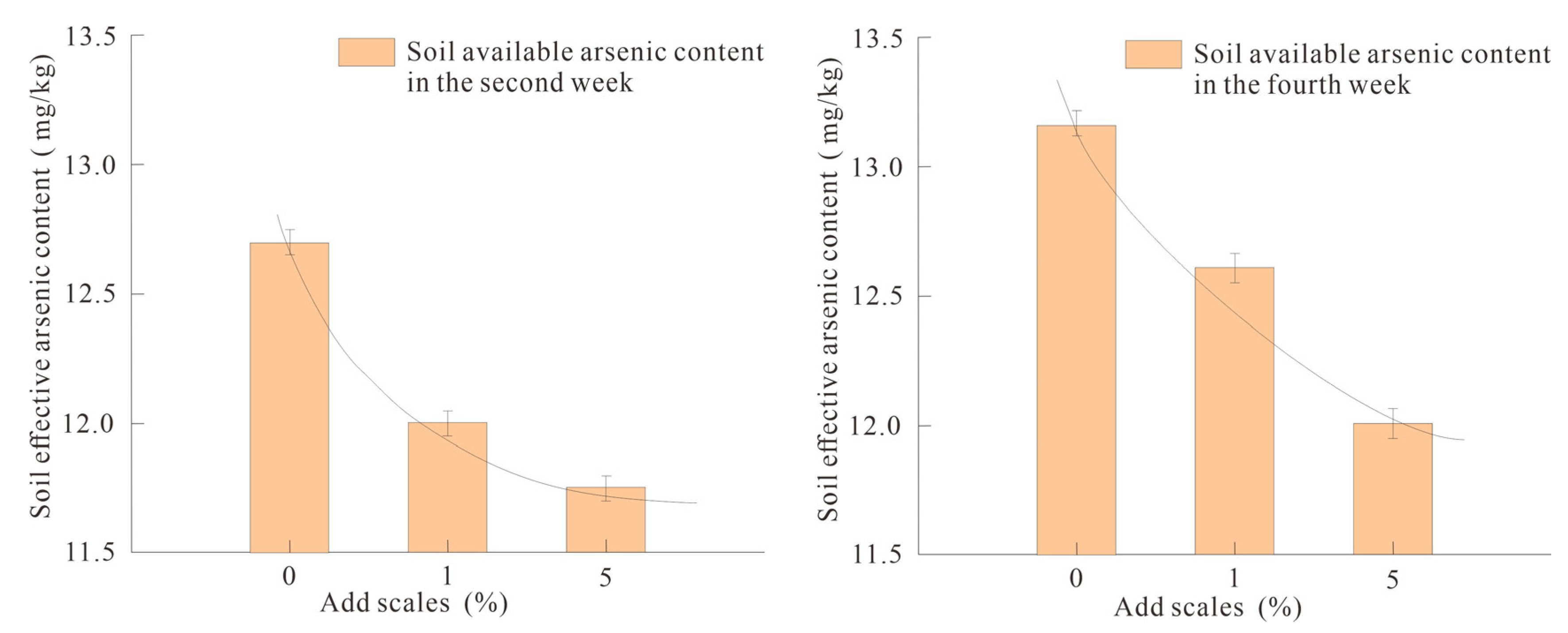
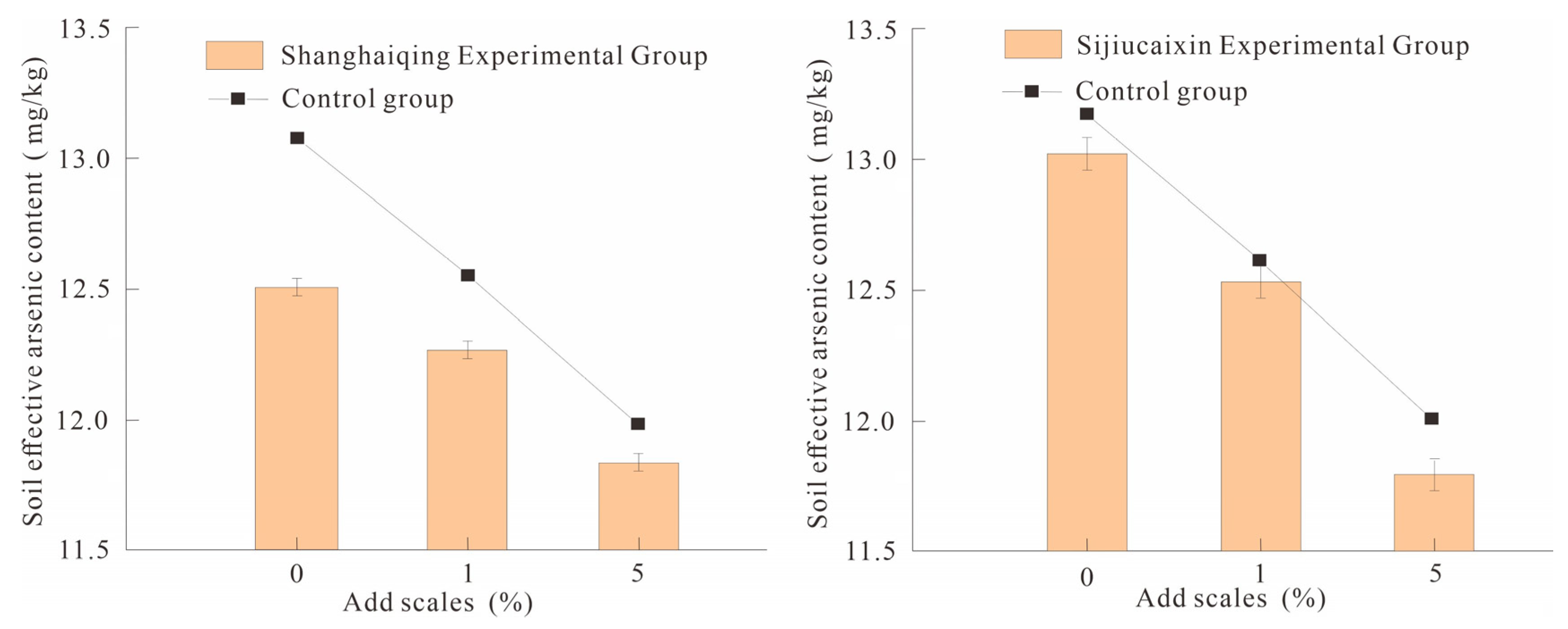
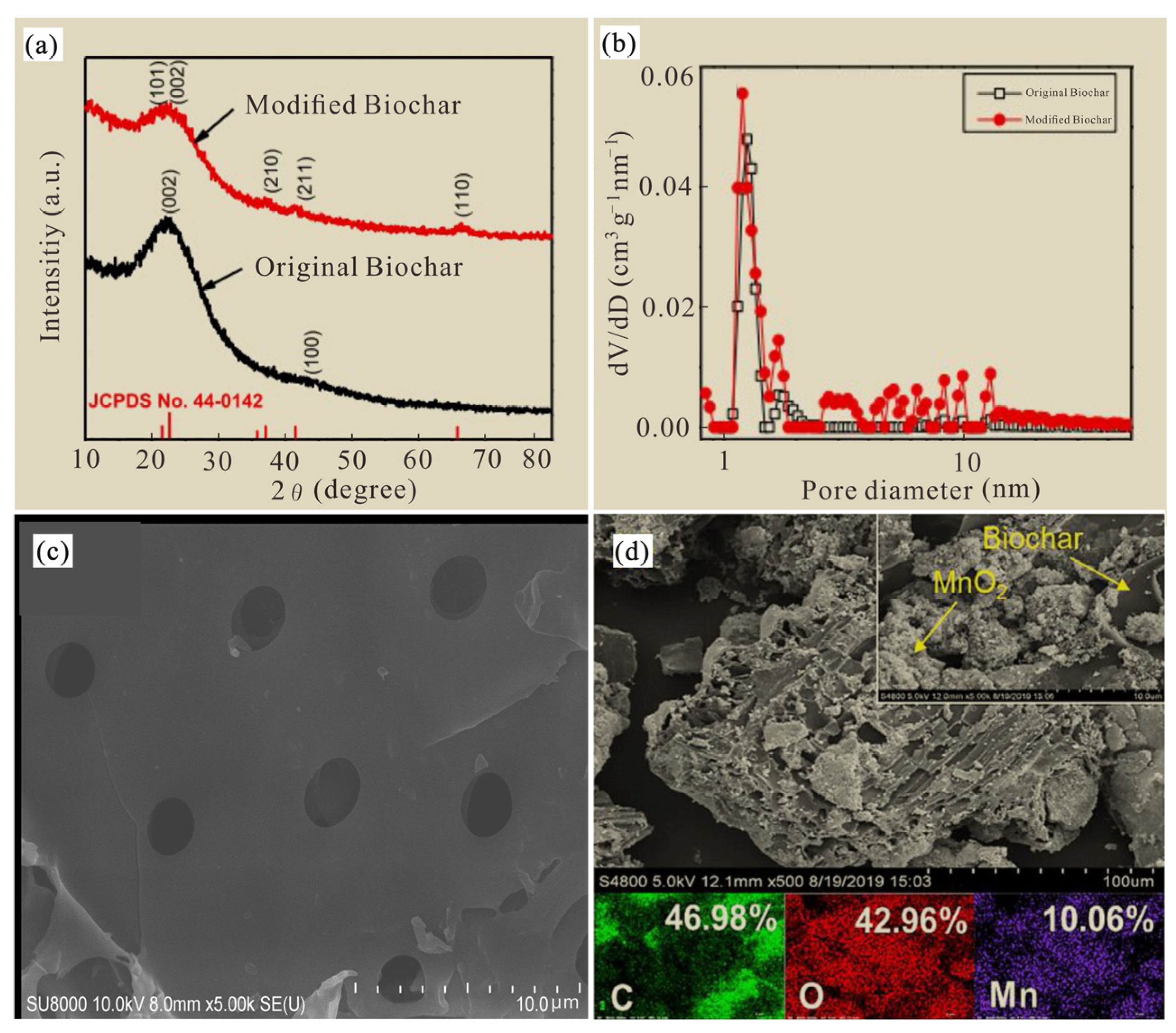
| pH | CEC/ (cmol·kg−1) | EC/ (μS·cm−1) | OM/ (g·kg−1) | TN/ (mg·kg−1) | TP/ (mg·kg−1) | As/ (mg·kg−1) |
|---|---|---|---|---|---|---|
| 7.69 | 15.01 | 725.33 | 2.28 | 0.85 | 0.80 | 16.4 |
| Detection Metrics | K+ | Ca2+ | Na+ | Mg2+ | Fe3+ | As |
|---|---|---|---|---|---|---|
| Content (mg/L) | 1.3 | 48.8 | 52.5 | 60.6 | 1.23 | 0.16 |
| Add Scales/ Crops | 0% | 1% | 5% |
|---|---|---|---|
| No crops were planted | CK0-1 | SY1-1 | SY5-1 |
| Shanghaiqing Brassica rapa | CK0-2 | SY1-2 | SY5-2 |
| Sijiucaixin Brassica rapa | CK0-3 | SY1-3 | SY5-3 |
| Passivator | Pseudo-First-Order Model | Pseudo-Second-Order Model | ||||
|---|---|---|---|---|---|---|
| qe (μg/g) | K1 | R2 | qe (μg/g) | K2 | R2 | |
| Nano MnO2 Modified Biochar | 381.77 | 0.11 | 0.81 | 389.47 | 0.60 × 10−3 | 0.97 |
| Passivator | Langmuir | Freundlich | ||||
|---|---|---|---|---|---|---|
| qe (μg/g) | K1 | R2 | n | K2 | R2 | |
| Nano MnO2 modified biochar | 58.12 | 0.15 | 0.98 | 2.14 | 10.95 | 0.93 |
Disclaimer/Publisher’s Note: The statements, opinions and data contained in all publications are solely those of the individual author(s) and contributor(s) and not of MDPI and/or the editor(s). MDPI and/or the editor(s) disclaim responsibility for any injury to people or property resulting from any ideas, methods, instructions or products referred to in the content. |
© 2023 by the authors. Licensee MDPI, Basel, Switzerland. This article is an open access article distributed under the terms and conditions of the Creative Commons Attribution (CC BY) license (https://creativecommons.org/licenses/by/4.0/).
Share and Cite
Li, Y.; Xiao, S.; Zhang, X.; Qu, J.; Ren, Y. A Study on the Soil Passivation of Nano-Manganese Dioxide-Modified Biochar under High-Arsenic Water Irrigation. Appl. Sci. 2023, 13, 9606. https://doi.org/10.3390/app13179606
Li Y, Xiao S, Zhang X, Qu J, Ren Y. A Study on the Soil Passivation of Nano-Manganese Dioxide-Modified Biochar under High-Arsenic Water Irrigation. Applied Sciences. 2023; 13(17):9606. https://doi.org/10.3390/app13179606
Chicago/Turabian StyleLi, Yuepeng, Shunyu Xiao, Xin Zhang, Jihong Qu, and Yu Ren. 2023. "A Study on the Soil Passivation of Nano-Manganese Dioxide-Modified Biochar under High-Arsenic Water Irrigation" Applied Sciences 13, no. 17: 9606. https://doi.org/10.3390/app13179606
APA StyleLi, Y., Xiao, S., Zhang, X., Qu, J., & Ren, Y. (2023). A Study on the Soil Passivation of Nano-Manganese Dioxide-Modified Biochar under High-Arsenic Water Irrigation. Applied Sciences, 13(17), 9606. https://doi.org/10.3390/app13179606





